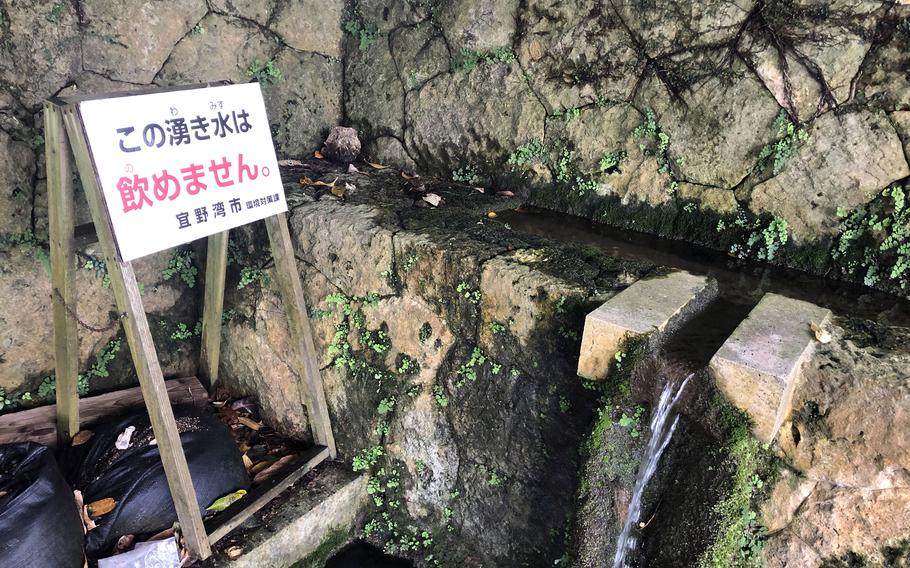
A sign warns people not to drink water water from Chunnagaa, a spring about a quarter-mile from Marine Corps Air Station Futenma, Okinawa. (Keishi Koja/Stars and Stripes)
CAMP FOSTER, Okinawa — Okinawa prefecture is still seeking the “origin of forever chemicals” after high PFAS levels were detected in groundwater around a Marine base on Okinawa, according to a recent government report.
The prefecture’s Environmental Protection Division discovered PFAS above Japan’s provisional safe drinking water standard in 19 of 37 sites it sampled around Marine Corps Air Station Futenma between August and January, according to an annual report released by the division in April.
Japan’s provisional standard is 0.05 micrograms per liter.
“Depending on the amount, the contaminants might affect the waters for decades,” a division spokesman told Stars and Stripes by phone Wednesday. “It is important to determine the origin to take countermeasures and be able to use the site smoothly after it’s returned.”
The Japanese and U.S. governments are building a new airfield farther north on Okinawa to eventually replace MCAS Futenma.
A synthetic chemical, PFAS, and its components, PFOS and PFOA, are found in firefighting foam, also known as aqueous film forming foam, once commonly used on some U.S. military bases.
The Defense Department has removed the foam from all its Navy and Marine Corps bases in Japan and from all Army bases and Misawa Air Base on Honshu, the largest of the country’s four main islands, U.S. Forces Japan said in June 2023. The system that employed firefighting foam at Yokota Air Base in western Tokyo is no longer in use, base commander Col. Andrew Roddan said in June 2023.
The U.S. Environmental Protection Agency dubbed PFAS and its components as “forever chemicals” because they persist a long time in the environment. They pose a potential danger to the body’s immune system and may be linked to kidney and testicular cancer, low birth weight in newborns and lower anti-body response to vaccines, according to the Centers for Disease Control and Prevention.
On Okinawa, an observation well in an undisclosed location downstream of MCAS Futenma registered 4.5 micrograms per liter of a combined PFOS and PFOA mixture — 90 times the provisional safety standard, according to the division’s report.
High levels were also found downstream of the base. Aranakigaa, a spring about a quarter-mile from MCAS Futenma’s southwestern fence line, registered 1.1 micrograms per liter, 22 times the provisional standard, the report said.
Chunnagaa, another spring about a quarter-mile from the northwestern fence line, registered 0.99 micrograms per liter, almost 20 times the provisional standard, according to the report.
The contamination levels around MCAS Futenma are “still at a high level,” the report states. The prefecture assumes that the toxins are being retained for a long period at the vadose zone, the area from the surface to the groundwater table, and infiltrate the groundwater following interaction with rainwater.
Marine Corps Installations Pacific referred queries about the toxins to U.S. Forces Japan, which did not immediately respond to emails Thursday.
MCAS Futenma was the scene of a 38,000-gallon firefighting foam spill into a nearby stream and neighborhood in April 2020.
Determining the exact origin of the contaminants is difficult and more data must be gathered, according to the division’s report.
“We still think that the contamination comes from the base, since the level is higher downstream,” the environment division spokesman said.
Some government officials in Japan may speak to the media only on condition of anonymity.
“We asked to the U.S. Marines to allow us to conduct sampling during the Japanese fiscal year 2023, but we haven’t received any response at the moment,” the spokesman said. “We want to use this data as a reasoning to make it happen.”